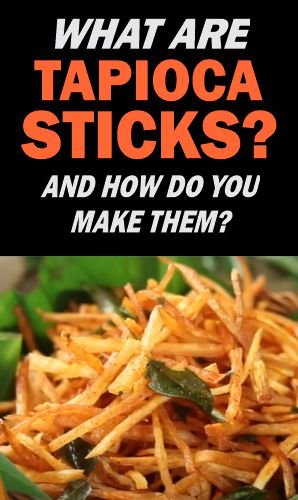Quickly learn about cassava tapioca sticks – preparation, nutritional benefits, and creative serving ideas to enjoy this versatile treat on any occasion.
Crunchy, golden, and irresistibly delicious, cassava/tapioca sticks are a snack sensation that’s taking the world by storm.
Whether enjoyed as a crispy side dish, a street-food favorite, or a homemade treat, these sticks offer the perfect balance of texture and flavor.
Loved for their satisfying crunch and versatility, they can be seasoned, fried, or baked to suit any palate.
Beyond their irresistible taste, they provide a gluten-free alternative to traditional snacks, making them a go-to choice for those seeking something both indulgent and wholesome.
With roots in diverse culinary traditions, cassava/tapioca sticks are more than just a snack; they’re a testament to the rich potential of this humble tuber, delivering satisfaction in every crispy, golden bite.
Celebrated for their satisfying texture and subtle flavor, tapioca sticks, just like boiled cassava roots offer a versatile snacking option.

Table of Contents
- What are Tapioca Sticks?
- Cassava Sticks: Nutritional Benefits and Uses
- Step-by-Step Guide to Preparing Tapioca Sticks
- Cassava Sticks Serving Suggestions and Variations
- Conclusion
What are Tapioca Sticks?
Tapioca sticks, also known as cassava sticks or maragenasina sonte, not to be confused with cassava chips and yuca fries, are a popular deep-fried snack made from the starchy root of the cassava plant.
These crispy treats are enjoyed in many tropical cassava-producing regions.
They are celebrated for their unique crunch and subtle flavor, which makes them a favorite at social gatherings and festive occasions.
Origins and Cultural Significance
The cassava plant, from which tapioca sticks are made, is a staple food in several cultures, symbolizing sustenance and resilience.
Its acceptance is evident in various culinary traditions, with cassava sticks being a prime example of how basic ingredients can be transformed into delightful snacks.
This snack’s global appeal shows its universal charm and the ingenuity of different cultures.
Related Posts
How to Make Boba Balls without Tapioca
How to Use Cassava Syrup as a Thickener
What is Tapioca Pearls and How do You Make it?
Cassava Sticks: Nutritional Benefits and Uses
Cassava, the primary ingredient in cassava sticks, offers a range of nutritional benefits.
This starchy tuber is rich in carbohydrates, providing a quick energy boost.
It is also high in dietary fiber, which supports digestive health and helps maintain a feeling of fullness.
Cassava contains essential vitamins and minerals, including Vitamin C and folate, and is naturally gluten-free, making tapioca sticks suitable for those with gluten sensitivities.
Cassava Beyond the Sticks
Beyond cassava sticks, cassava is used worldwide in various forms. In Africa, it is often boiled or roasted as a staple food.
In Latin America, cassava is featured in dishes like Brazilian “pão de queijo” (cheese bread).
In Asian cuisines, it appears in both desserts and snacks, showcasing its adaptability and global significance.
Step-by-Step Guide to Preparing Tapioca Sticks
Creating crispy cassava sticks involves a detailed process that begins with selecting and preparing the cassava root.
Ingredients and Preparation
- Selection: Choose fresh, firm cassava roots without blemishes.
- Peeling: Remove the thick outer layer with a sharp knife. Rinse thoroughly to remove dirt.
- Slicing: Cut the cassava into uniform sticks, about 1/4-inch thick.
Cooking Process
- Boiling: Place the sliced cassava in water and boil for 15-20 minutes until tender but firm. Avoid overcooking to prevent mushiness.
- Drying: Drain the boiled cassava and let it cool. Dry the sticks on a cloth or paper towel to remove excess moisture.
Frying
- Heating Oil: Heat oil in a deep fryer or skillet to 350°F (175°C).
- Frying: Add the dried cassava sticks in batches, frying until golden and crispy (3-5 minutes per batch). Drain on paper towels.
Seasoning
While still warm, season the tapioca sticks with salt or your favorite spices for enhanced flavor.
Cassava Sticks Serving Suggestions and Variations
Tapioca sticks can be served in various ways to suit different tastes and occasions.
Dipping Sauces
Pair tapioca sticks with a variety of dipping sauces:
- Classic options: Tomato ketchup, garlic mayonnaise, or Sriracha.
- Sophisticated options: Aioli, yogurt-based dip with herbs, or tamarind chutney.
Sweet Variations
Transform cassava sticks into a dessert by sprinkling with powdered sugar and cinnamon or cocoa powder. Serve with chocolate sauce or fruit compote for a sweet treat.
Spicy Versions
For a spicy kick, season the sticks with chili powder, ground cumin, and paprika before frying. These can be served with sour cream or yogurt dip.
Culinary Uses
Incorporate crushed cassava sticks as a crunchy topping for salads or soups, or include them in Asian-inspired dishes like noodle bowls or stir-fries for added texture.
Conclusion
Tapioca sticks are a delightful snack that combines simplicity with versatility. Whether enjoyed on their own or as part of a larger dish, they offer a satisfying crunch and unique flavor.
Their preparation and serving possibilities make them a valuable addition to any culinary repertoire.
Cassava/tapioca sticks are more than just a snack, they’re a delicious fusion of tradition, versatility, and satisfying crunch.
Whether you enjoy them as a savory treat or a lightly seasoned delight, their appeal is undeniable.
Perfect for any occasion, they offer a gluten-free alternative that caters to a wide range of dietary preferences.
With their growing popularity, these crispy sticks continue to win over food lovers worldwide.
So, whether homemade or store-bought, cassava/tapioca sticks are a must-try for anyone craving a flavorful and crispy indulgence.
Give them a taste, and you’ll see why they’re an all-time favorite!
References:

Chimeremeze Emeh is a writer and researcher passionate about Africa’s most transformative root crop—cassava. Through his work at cassavavaluechain.com, he explores the entire cassava industry, from cultivation and processing to its diverse applications in food, health, and industrial use.
He also writes for palmoilpalm.com, where he shares his extensive experience and deep-rooted knowledge of palm oil, covering red palm oil, palm kernel oil, and refined products. His work there reflects his lifelong connection to agriculture and his commitment to promoting sustainable value chains in Africa.
Driven by curiosity and purpose, Chimeremeze aims to shed light on how cassava continues to empower communities, strengthen food systems, and link traditional farming wisdom with modern innovation.

